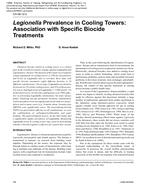Description
Chemical biocide control in cooling towers is a critical part of the overall prevention strategy against Legionella and Legionnaires’ disease. The purpose of this study was to analyze a large population of cooling towers (2,590) for the presence and levels of Legionella and to correlate these data with specific biocide treatments (eight different biocides in 28 different combinations). On average, Legionella was found to be present in 13% of the cooling towers, and 18% of these positive towers had high levels of Legionella (> 1,000 cfu/ml; 2% of the total towers). No biocide combinations were 100% effective in preventing Legionella colonization, but none always failed. Oxidizing biocide (primarily bromine) combinations with nonoxidizers were not significantly better than two nonoxidizers and in many cases (e.g., bromine alone, bromine plus DBNPA) were significantly worse. The nonoxidizing biocide THPS was particularly effective in all combinations, as were the combinations of carbamate/isothiazoline and quat/ bromine. The quat/carbamate towers, on the other hand, had a significantly higher prevalence of Legionella. Monitoring Legionella levels in cooling towers may assist in determining whether a biocide regimen is effective for a particular system.
Units: SI
Citation: Symposium, ASHRAE Transactions, vol. 112, pt. 1
Product Details
- Published:
- 2006
- Number of Pages:
- 9
- File Size:
- 1 file , 140 KB
- Product Code(s):
- D-27961




